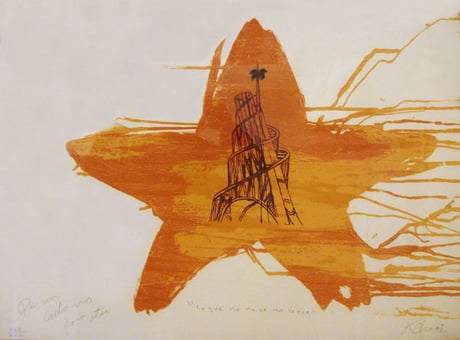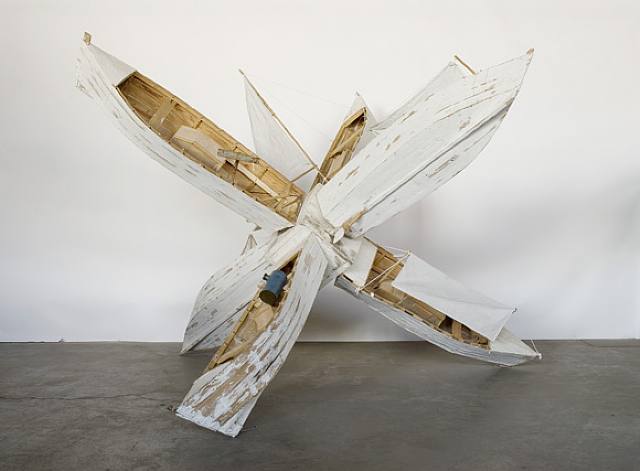Art & Exhibitions
artnet Asks: Kcho
The Cuban artist is planning to turn a Havana barrio into "a museum without walls."

The Cuban artist is planning to turn a Havana barrio into "a museum without walls."

Lorraine Rubio

Alexis Leiva Machado (known as Kcho) was born on the Isla de la Juventud in Nueva Gerona, Cuba. As a child, he was influenced by the conceptual work of Bruce Nauman, and went on to obtain his BA in fine arts from the National School of Fine Arts in Havana. He gained international attention as an artist in 1995, winning the grand prize at South Korea’s Gwangju Biennale. Kcho’s work is connected to his loyalty and love for his childhood home island (located miles off the mainland) and Cuba as a nation. His oeuvre of paintings, sculptures, and drawings is made up of boats, propellers, and imagery associated with the sea and patriotic symbols. His work has been exhibited internationally, including at the Museum of Contemporary Art in Los Angeles and at the Reina Sofía National Museum in Madrid, Spain. artnet News caught up with the artist to hear about his works in the pipeline and his first memories of wanting to be an artist.
When did you know you wanted to be an artist?
I have always spoken about a memory I have of when I was around five years old. I remember seeing my mother create a paste of papier-mâché, which she then would use for creating various works and adding detail to them. That moment and that process marked my life. Being with my mother as she papier-mâchéd, giving her company as she created, marked me forever and determined my path.

Kcho, Lo Que No Nace No Crece (1992)
Serigraph on paper, 19 1/2 x 27 1/2 in., ed. of 25
Photo courtesy of the artist and Marlborough Gallery.
What inspires you?
There is an event that is worth mentioning. When I was around 11 or 12 years old, I was walking on the streets of the Isla de la Juventud, my beautiful island to the south of the island of Cuba, and stepped into what was then the municipal gallery. I came across a treasure that hung on the walls, reproductions—although, to me, they seemed to be original works. I remember that it was the first time that I saw a work by Goya. There was a reproduction of the Maja Desnuda; there was also a reproduction of Las Meninas by Velázquez; the Garden of Earthly Delights by Bosch; and there were drawings by Michelangelo, da Vinci, Raphael, Dürer, Miró, Dalí, Picasso, Rodin, and other great masters in the history of art. These works were there, on that island, as in many places in Cuba, because a great Cuban, Alejo Carpentier, allocated the winnings of his Cervantes Prize toward the purchase of reproductions of important and historical works of art for every Cuban province. This moment, and the ability to enjoy these treasures every day, I can tell you, definitely marked my path.

Kcho, Luz Propia (Personal Light) (2007)
Mixed media
Photo courtesy of latinamericanart.com
If you could own any work of modern or contemporary art, what would it be?
I like this question very much. I have owned various works of modern and contemporary art. Ever since I was young, I have worked on a collection of Cuban art from the principal figures of the Cuban avant-garde. I also have some works of international art. But if you ask me what I would like to have, I wouldn’t like to own it for myself, but I would like to see in the Museo de Bellas Artes de la Habana [Wilfredo Lam’s] La Jungla. I consider it very important that La Jungla is in the permanent collection at MoMA, and accomplishing the mission that Lam proposed, a decolonizing mission—Lam pursued this throughout his life. Cubans being able to possess La Jungla: that I would like, even if for a short period of time. Although, I would also like to have Duchamp’s Fountain, or be able to see Mario Merz’s The Great Glass or Igloo, or any of the other masterpieces that inspired the history of art.

Kcho, Untitled (2006)
Wood, metal, and marble, 18 x 16 in.
Photo courtesy of the artist and Tresart.
What are you working on at the moment?
At this very moment, I am working on many things; I never work solely on one thing, I am always working, taking many, many paths. I am working on the most complex of my installations for the next Havana Biennial, which will take place in May and June of 2015. For this work, I am embarking upon—and we have already begun—turning a barrio in Havana called Romerillo into an organic museum, a museum without walls, where all spaces will display art democratically: public parks, bus stops, the market, the space of our Art Laboratory, which we have created in this very neighborhood, people’s homes, and all areas of action. Art will be displayed everywhere. That is the intention of this museum. This is the project on which I am so keenly working. I am also finishing other projects. For example, right now, I am in Oaxaca, Mexico, working on the installation of an exhibition that opened on September 6 in the Centro de las Artes de San Agustín, founded by Francisco Toledo. The exhibition is curated by Jorge Contreras. I am also preparing for two other exhibitions at the Museo de Arte Contemporáneo de Caracas in the following October, and the Museo de Arte Contemporáneo in Santiago, Chile, which will take place in March of the following year. As you see, I am always working.
When not making art, what do you like to do?
I try to make art out of everything I do; I try to have every action of my life be creative, not only for myself, but also for the world that surrounds me and society. I try to carry the energy beyond my work and the work of other artists—helping to create museums, collections, and spaces to develop creative activity.